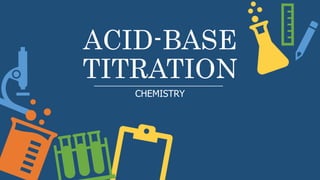
TITRATION PPT.pptx for cape chemistry unit 1
- 2. OBJECTIVES: Define the terms standard solutions and acid-base titration or volumetric analysis. Recall that the reaction between an acid and a base is a neutralization reaction. Precisely explain how the change in color of the indicator tells the endpoint of a neutralization reaction. Perform calculations to determine the molar concentration and mass concentration of an unknown solution using a standard solution from acid-base titration reactions with.
- 4. LAB ACTIVITY- LET US EXPLORE! •AIM OF LAB: •To determine the concentration of dilute hydrochloric acid in mol/dm3 and g/dm3 reagent using 0.3mol/dm3 of the standard solution; sodium carbonate .
- 5. Calculating the mass of the sodium carbonate required to prepare a solution of concentration 0.3mol/dm3- Formula • Molar concentration ×molar mass ×Volume 1000
- 6. •Solution, Concentration and titrations! •The concentration of a solution • This refers to the amount of solute dissolved in a solvent to make a solution. The units are usually expressed in moles per cubic decimeter (mol/dm3). This is the molar concentration. Concentration of solution (mol/dm3) = • number of moles of solute (mol) • Volume of solution (dm3) • In calculations involving solution concentration in mol/dm3 remember: • To change mass in grams to moles • To change cm3 to dm3 by dividing by 1000 • The moles of the solute = concentration x volume • The volume of solution = moles of solute • Concentration
- 7. Example 1 • Calculate the concentration of a solution of potassium hydroxide ( M = 56.0) containing 3.50 g of KOH in 125 cm3 of solution.
- 8. •Solution, Concentration and titrations! •Mass concentrations calculations • There is another way of expressing the concentration, known as the mass concentration. This is the mass of solute dissolved in 1000 cm3 (1 dm3) of solution. The unit is g.dm-3 or g/dm3. • • • Mass concentration = mass of solute • Volume of solution (dm3) • And • • Mass concentration = Molar concentration x molar mass of solute / molar mass
- 9. Acid – base titrations • A titration is used to determine the amount of substance present in a solution of unknown concentration (analyte) by reacting it quantitatively with a solution of known concentration (the standard solution or titrant). • The reaction between an acid and base is known as a neutralisation reaction. The acid and base react with each other exothermically (heat was given off) to produce salt and water. In this case the base must be soluble (alkali).
- 10. Acid – base titrations • We add the acid gradually to the alkali until the alkali has been neutralised (completely used up). • We use an acid-base indicator to find out when the acid has just reacted completely with the alkali. • The point at which neutralisation occurs is known as the end point of the titration. • At the end point, the colour of the indicator suddenly changes. • Methyl orange and phenolphthalein are two examples of this type of indicator. • Their respective colours in an acidic and an alkaline solution are given:
- 11. Indicator Colour in an acidic solution Colour in an alkaline solution Methyl orange Red yellow phenolphthalein Colourless pink
- 12. Calculating solution concentration by titration • In order to calculate solution concentration from titrations results we need to know: • the volume and concentration of the solution in the burette eg. The acid • the volume of the solution in the flask • the balanced equation for the reaction
- 13. Remember… Safety First! (Enter your own creative tag line above)